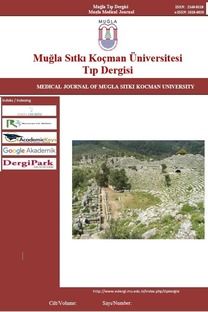Türkiye Güneybatısı’ndan Retrospektif Çalışma: Koroziv Madde Alımına Minimal İnvaziv Yaklaşım
Konservatif İzlem, Koroziv Madde, Özofagoskopi
A Retrospective Study in Southwest of Turkey: Minimally Invasive Approach in Corrosive Substance Ingestion
Conservative Follow-Up, Corrosive Substance, Esophagoscopy,
___
- 1. Efe E, Altaş N, Dikmen Ş, Melikoğlu M. Koroziv Madde Alımı Nedeniyle Yatırılan 139 Olgunun Retrospektif Değerlendirilmesi: Epidemiyolojik Çalışma. Güncel Pediat. 2013;11:107-13.
- 2. Abbas A, Brar TS, Zori A, Estores DS. Role of Early Endoscopic Evaluation in Decreasing Morbidity, Mortality, and Cost After Caustic Ingestion: A Retrospective Nation wide Database Analysis. Dis Esophagus. 2017;30:1-11.
- 3. Karakuş OZ, Ulusoy O. Koroziv Madde Alımı: Önleme ve Tedavi. Türkiye Klinikleri J Ped Sciences. 2015;1151-8.
- 4. Melek M, Edirne Y, Çobanoğlu U, Ceylan A, Can M. An Analysis of Corrosive Substance Ingestion of Children in Eastern Turkey. East J Med. 2008;13:1-6.
- 5. Ripoll NT, Martínez LS, Habimana AJ, Trenchs SM, Vila MV, Luaces CC. Ingestion of Caustic Substances: An Analysis of the Safety and Benefit of a Less Aggressive Protocol. Ann Pediatr. 2019;90(4):207-12.
- 6. Göllü G, Savaş NA, Karaemir G, Şimşek A, Ulus R, Dikmen B, et al. Koroziv Madde İçimi Hakkında Annelerin Bilgi Düzeylerinin Belirlenmesi. Mersin Üni Sağ Bil Derg. 2016;9:138-43.
- 7. Kutlu T. Çocuklarda Koroziv Özofajitler. İstanbul Üni Cerrahpaşa Tıp Fak Sürekli Tıp Eğit Etk. 2001:169-77. 8. Çördük N, Buke AS, Bağcı S, Acar K, Herek O. Çocuklarda Koroziv Madde İçiminin Ekonomik Etkisi ve Adli Takibi. Çocuk Cerr Derg. 2009;23:114-9.
- 9. İllerin Sosyoekonomik Gelişmişlik Sıralaması SEGE 2011 http://www.ika.org.tr/upload/haberler/Illerin-Sosyo-Ekonomik-Gelismislik-Siralamasi-Guncellendi-810676.pdf
- 10. Faz AA, Arsan F, Peyvandi H, Oroei M, Shafagh O, Peyvandi M, et al. M. Epidemiologic features and outcomes of caustic ingestions; a 10-year-cross-sectional study. Emergency. 2017;5:56-66.
- 11. Rafeey M, Ghojazadeh, M, Mehdizadeh A, Hazrati H, Vahedi L. Inter continental comparison of caustic ingestion in children. Korean J Pediatr. 2015;58:491-500.
- 12. Thomson M, Tringali A, Dumonceau JM, et al. Pediatric Gastrointestinal Endoscopy: European Society for Paediatric Gastroenterology Hepatology and Nutrition and European Society of Gastrointestinal Endoscopy Guidelines. J Pediatr Gastroenter Nutr. 2017;64:133-53.
- 13. Gupta SK, Rana AS, Gupta D, Jain G, Kalra P. Unusual Presentation of Caustic Ingestion and its Surgical Treatment: A Case Report. J Maxillofac Oral Surg. 2011;10:74-6.
- ISSN: 2148-8118
- Yayın Aralığı: Yılda 3 Sayı
- Başlangıç: 2014
- Yayıncı: Muğla Sıtkı Koçman Üniversitesi
Ketojenik Diyet ve Duygudurum Bozukluğu
Mustafa BAYRAKTAR, Hacı AYDEMİR
Emre GÜLTAÇ, Fatih CAN, Cem Yalın KILINÇ, Hıdır TANYILDIZI, Ahmet Emrah ACAN, Nevres Hürriyet AYDOĞAN
Vulvanın Paget Hastalığı: Olgu Sunumu
Ayhan ATIGAN, Soner GÖK, Yeliz ARMAN KARAKAYA
Yetişkinlerde Koroner Arter Fistülleri: Koroner BT Anjiyografi ile Değerlendirme
Sporcularda Kronik Dental Lezyonların Kas Kuvvetine Etkisi
Tuğba KOCAHAN, Osman HAMAMCILAR, Aydın BALCI, BİHTER AKINOĞLU, Nevres Hürriyet AYDOĞAN, Adnan HASANOĞLU
Erkek Hastada Cilt Metastazı ile Tespit Edilen Meme Karsinomu Olgu Sunumu
Coronary Artery Fistulas in Adults: Evaluation with Coronary CT Angiography
Rektum Kanserlerinde Sfinkter Koruyu Girişimlerin Neoadjuvan Kemoradyoterapi ile İlişkisi
Muharrem ÖZTAŞ, İsmail ÖZERHAN, Armağan GÜNAL, Mehmet BEYZADEOĞLU, Yusuf PEKER, Sadettin ÇETİNER
etişkinlerde Koroner Arter Fistülleri: Koroner BT Anjiyografi ile Değerlendirme
Ali İhsan UYSAL, BAŞAK ALTIPARMAK, Melike KORKMAZ TOKER, Süleyman Cüneyt KARAKUŞ, Semra GÜMÜŞ DEMİRBİLEK
